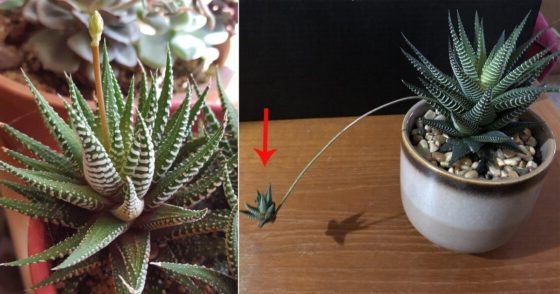Are you curious about the fascinating world of haworthia plants and their exquisite flowering stem blooms? Well, you’re in luck because today we will delve into the enchanting beauty and intricacies of haworthia flowering stem bloom.
Whether you are a seasoned plant enthusiast or just starting your green thumb journey, this article will provide you with valuable insights and practical tips to ensure successful haworthia flowering. So, let’s dive right in and discover the wonders of haworthia flowering stem bloom together!
Blooming Beauty: The Haworthia Flowering Stem Bloom Guide
Haworthia plants are beloved by many succulent enthusiasts for their unique appearances and low-maintenance nature. While these plants are often admired for their rosette-shaped leaves, they can also surprise and delight with the occasional flowering stem bloom.
In this article, we will explore the fascinating process behind haworthia flowering stem blooms, the factors that contribute to their occurrence, and how to care for your haworthia during this special time.
Understanding Haworthia Flowering Stem Blooms
Haworthias typically bloom during spring and summer, although the exact timing can vary depending on the species and conditions.
The flowering stem, also known as an inflorescence, emerges from the center of the rosette and extends upwards. These stems can reach varying heights, ranging from a few inches to a foot or more, depending on the haworthia species.
One of the most captivating aspects of haworthia flowering stem blooms is the array of beautiful flowers that appear along the stem.
These flowers come in a variety of colors, including white, yellow, pink, and red. Each flower is typically small in size, but collectively they create a stunning display.
Read More: About Dying Aquarium Plants
Factors Influencing Haworthia Flowering Stem Blooms
Several factors contribute to the blooming of a haworthia plant’s flowering stem:
- Age:
Haworthias generally need to reach a certain maturity level before they can produce flowering stems. Younger plants may not have developed enough energy reserves to support the energy-intensive process of blooming.
- Light:
Sufficient light is crucial for triggering the blooming process. Haworthias grown in bright, indirect light are more likely to flower compared to those in low light conditions.
- Temperature:
Haworthias prefer moderate temperatures between 65°F and 80°F (18°C to 27°C). Cooler temperatures can delay or inhibit blooming.
- Season:
As mentioned earlier, haworthias typically bloom in spring or summer, aligning with their natural growth cycle.
- Environmental Stress:
Some haworthia species bloom as a response to stress. Stressors like root-bound conditions or slight neglect can trigger a bloom.
Caring for Haworthia During Flowering Stem Bloom
When your haworthia begins to bloom, it’s essential to make a few adjustments to ensure the plant thrives. Here are some care tips specifically tailored for the flowering stem bloom phase:
Provide Adequate Light
During this stage, your haworthia requires bright, indirect light to support healthy flower development. Place it near a window with filtered sunlight or provide artificial grow lights if natural light is limited. Avoid exposing your plant to direct sunlight, as it can scorch the leaves and flowers.
Optimize Temperature and Humidity
Maintain a temperature range of 65°F to 80°F (18°C to 27°C) to promote optimal growth and flowering. Avoid placing your haworthia near cold drafts or heat sources like heaters or air conditioners. Additionally, ensure adequate humidity levels by misting the plant occasionally or placing a tray with water nearby to increase ambient moisture.
Watering During the Flowering Stem Bloom
As with regular haworthia care, it’s crucial to strike a balance with watering. During the flowering stem bloom phase, you should continue following the “soak and dry” method. Allow the soil to dry out between waterings to prevent overwatering, which can lead to root rot. Be cautious not to directly pour water onto the flowering stem and flowers, as this can cause fungal diseases.
Fertilization
While haworthias generally do not require frequent fertilization, providing a diluted, balanced succulent fertilizer once a month during the blooming period can help support healthy growth and vibrant flowers. Follow the manufacturer’s instructions for proper dilution ratios.
Observation and Careful Monitoring
During the flowering stem bloom, it’s essential to closely observe your haworthia for any signs of distress or pests. Inspect the leaves, stem, and flowers regularly, and take prompt action if any issues arise. Removing dead flowers can help maintain the overall appearance of the plant and prevent the formation of mold or pests.
The flowering stem bloom of a haworthia is truly a delightful sight for succulent enthusiasts. The emergence of vibrant flowers against the backdrop of the plant’s distinctive rosette-shaped leaves is a testament to the beauty and resilience of these fascinating plants.
By understanding the factors that contribute to haworthia flowering stem blooms and providing the appropriate care during this period, you can enjoy the full glory of these captivating succulents.
Remember to be patient and continue providing consistent care, and your haworthia will reward you with its spectacular blooms time and time again.
Read More: About How To Keep Grass Out Of Wildflowers?
Frequently Asked Questions (FAQs)
A Haworthia flowering stem typically blooms once a year, usually during the spring or summer months.
Some signs that a Haworthia flowering stem is about to bloom include the emergence of a long, slender stalk from the center of the plant, the growth of buds at the top of the stalk, and the gradual opening of the buds into flowers.
A Haworthia flowering stem bloom typically lasts for several weeks, with individual flowers often remaining open for a few days before wilting.
Yes, a Haworthia plant can produce multiple flowering stems, especially if it is well-maintained and provided with the right conditions for growth.
If your Haworthia flowering stem doesn’t bloom, it could be due to various factors such as inadequate light, improper watering, or lack of nutrients. Ensure that you provide the plant with appropriate care, including sufficient sunlight, watering as needed, and providing a balanced fertilizer during the growing season.
No, not all Haworthia species produce flowering stems. Some species are known to bloom more readily than others, while some may rarely or never bloom under typical indoor conditions.
While it is more common to propagate Haworthia plants through offsets or leaf cuttings, it is possible to propagate from a flowering stem as well. Carefully remove the stem with a clean, sharp knife and allow it to callus for a day or two before planting it in well-draining soil.
It’s generally recommended to leave the Haworthia flowering stem intact even after blooming. The stem will naturally wither and dry out over time, but removing it prematurely can disrupt the plant’s growth cycle.
Final Thoughts
The haworthia flowering stem bloom is a fascinating and beautiful sight to behold. These unique succulents, known for their rosette-shaped leaves and spiky appearance, produce stunning tall stems that burst into bloom. The flowering stem showcases delicate, colorful flowers that add vibrancy to any garden or indoor space.
It is truly a treat for plant enthusiasts to witness the haworthia flowering stem bloom, as it showcases the plant’s ability to thrive and reproduce. So, whether you are a seasoned gardener or a beginner plant lover, witnessing the haworthia flowering stem bloom is an experience that you don’t want to miss out on.
Auto Amazon Links: No products found.
Perfect Plants Christmas Tree Saver 8oz. | Easy Use Xmas Tree Preserver Food | Have Healthy Green Christmas Trees All Holiday Season
$9.97 (as of November 25, 2025 23:26 GMT +00:00 - More info- Product prices and availability are accurate as of the date/time indicated and are subject to change. Any price and availability information displayed on [relevant Amazon Site(s), as applicable] at the time of purchase will apply to the purchase of this product.
Wilt-Pruf® Christmas Tree/Cutting Preserver Spray |Preserves Christmas Trees, Wreaths, Garlands, Cuttings and Carved Pumpkins | Reduces Needle Drop | Keeps Cut Trees Fresh Longer | Natural (32 oz)
$21.99 (as of November 25, 2025 23:26 GMT +00:00 - More info- Product prices and availability are accurate as of the date/time indicated and are subject to change. Any price and availability information displayed on [relevant Amazon Site(s), as applicable] at the time of purchase will apply to the purchase of this product.
Christmas Tree Watering Funnel – 39 Inch Adjustable 3-Section Design, Reusable & Spill-Free, Easy Watering for Real Christmas Trees
$10.70 (as of November 25, 2025 23:26 GMT +00:00 - More info- Product prices and availability are accurate as of the date/time indicated and are subject to change. Any price and availability information displayed on [relevant Amazon Site(s), as applicable] at the time of purchase will apply to the purchase of this product.
HoHoHoH2o Automatic Christmas Tree Watering System Device, Santa’s Tree Helper Keeps Your Christmas Tree Healthy and Fresh, Refillable 2.5 gallons Capacity Box - Silver/Festive
$99.95 (as of November 25, 2025 23:26 GMT +00:00 - More info- Product prices and availability are accurate as of the date/time indicated and are subject to change. Any price and availability information displayed on [relevant Amazon Site(s), as applicable] at the time of purchase will apply to the purchase of this product.
IPOOLTENG Christmas Tree Watering Funnel 3 Tube 1 Funnels 40 Inch - 3 Section Plastic Christmas Tree Funnel Waterer, Long Funnels for Watering Trees, No More Bending to Water
$13.59 (as of November 25, 2025 23:26 GMT +00:00 - More info- Product prices and availability are accurate as of the date/time indicated and are subject to change. Any price and availability information displayed on [relevant Amazon Site(s), as applicable] at the time of purchase will apply to the purchase of this product.
Zevo Flying Insect Trap Official Refill Cartridges - Fits Both Zevo Trap & MAX Indoor Fly Trap - Authentic Trap+Lock Technology to Catch Gnats, House & Fruit Flys (4 Official Refill Cartridges)
$14.97 (as of November 25, 2025 14:47 GMT +00:00 - More info- Product prices and availability are accurate as of the date/time indicated and are subject to change. Any price and availability information displayed on [relevant Amazon Site(s), as applicable] at the time of purchase will apply to the purchase of this product.
Traeger Grills Signature Blend 100% All-Natural Wood Pellets for Smokers and Pellet Grills, BBQ, Bake, Roast, 18 lb. Bag
$19.99 (as of November 25, 2025 14:47 GMT +00:00 - More info- Product prices and availability are accurate as of the date/time indicated and are subject to change. Any price and availability information displayed on [relevant Amazon Site(s), as applicable] at the time of purchase will apply to the purchase of this product.
TERRO Ant Killer Bait Stations T300B - Liquid Bait to Eliminate Ants - Bait System - 12 Count Stations for Effective Indoor Ant Control
$10.86 (as of November 25, 2025 14:47 GMT +00:00 - More info- Product prices and availability are accurate as of the date/time indicated and are subject to change. Any price and availability information displayed on [relevant Amazon Site(s), as applicable] at the time of purchase will apply to the purchase of this product.
Zevo Flying Insect Trap & 3 Refill Cartridges - Plug in Fly Trap & Indoor Bug Catcher for Gnats, House & Fruit Flies - Blue & UV Light Technology, Mess-Free Alternative to Bug Zapper
$25.96 (as of November 25, 2025 14:47 GMT +00:00 - More info- Product prices and availability are accurate as of the date/time indicated and are subject to change. Any price and availability information displayed on [relevant Amazon Site(s), as applicable] at the time of purchase will apply to the purchase of this product.
Victor Mouse Traps M150-12, Metal Pedal, Sustainably Sourced FSC Wood, Wooden Mouse Traps, 12 Metal Pedal Traps
$9.79 (as of November 25, 2025 14:47 GMT +00:00 - More info- Product prices and availability are accurate as of the date/time indicated and are subject to change. Any price and availability information displayed on [relevant Amazon Site(s), as applicable] at the time of purchase will apply to the purchase of this product.











